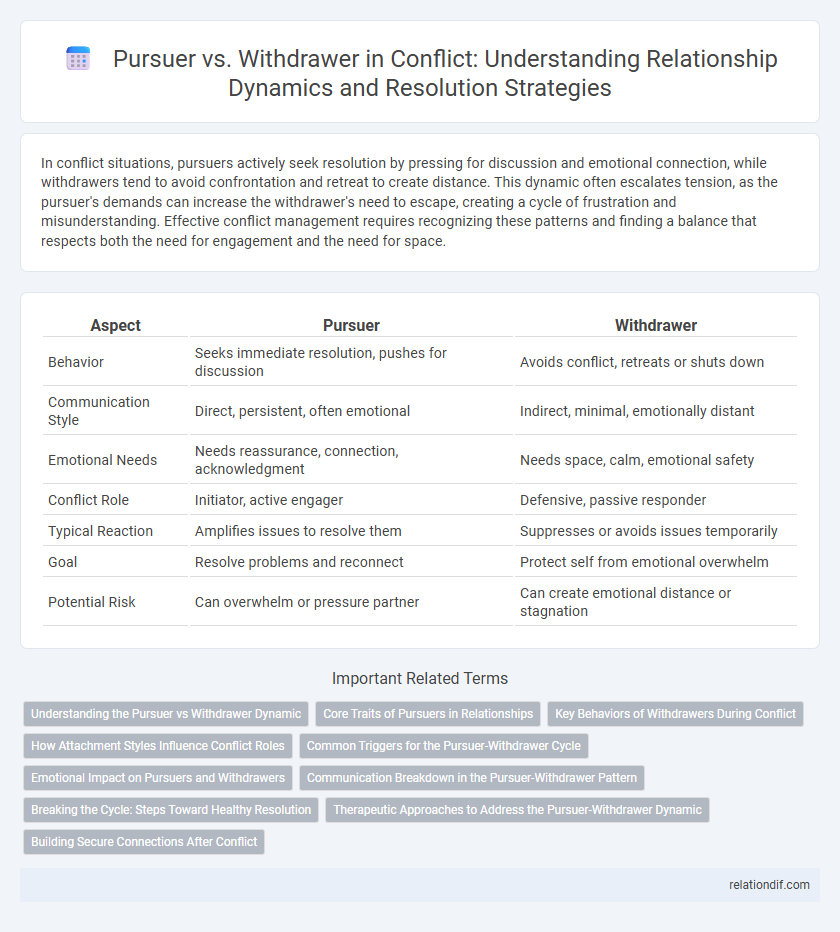In conflict situations, pursuers actively seek resolution by pressing for discussion and emotional connection, while withdrawers tend to avoid confrontation and retreat to create distance. This dynamic often escalates tension, as the pursuer's demands can increase the withdrawer's need to escape, creating a cycle of frustration and misunderstanding. Effective conflict management requires recognizing these patterns and finding a balance that respects both the need for engagement and the need for space.
Table of Comparison
| Aspect | Pursuer | Withdrawer |
|---|---|---|
| Behavior | Seeks immediate resolution, pushes for discussion | Avoids conflict, retreats or shuts down |
| Communication Style | Direct, persistent, often emotional | Indirect, minimal, emotionally distant |
| Emotional Needs | Needs reassurance, connection, acknowledgment | Needs space, calm, emotional safety |
| Conflict Role | Initiator, active engager | Defensive, passive responder |
| Typical Reaction | Amplifies issues to resolve them | Suppresses or avoids issues temporarily |
| Goal | Resolve problems and reconnect | Protect self from emotional overwhelm |
| Potential Risk | Can overwhelm or pressure partner | Can create emotional distance or stagnation |
Understanding the Pursuer vs Withdrawer Dynamic
The pursuer vs withdrawer dynamic in conflict reveals how one partner seeks closeness and demands resolution while the other retreats to avoid confrontation, leading to a cycle of tension. Recognizing these opposing behaviors helps identify communication breakdowns and emotional triggers, enabling more effective conflict management. Strategies focused on empathy and timing can bridge the gap between pursuit and withdrawal, fostering healthier interactions.
Core Traits of Pursuers in Relationships
Pursuers in relationships exhibit an intense need for closeness, often seeking constant communication and reassurance from their partners. Their core traits include high emotional expressiveness, a strong desire to resolve conflicts quickly, and difficulty tolerating distance or silence. This relentless pursuit can lead to feelings of overwhelm in their partners, especially those who tend to withdraw during conflicts.
Key Behaviors of Withdrawers During Conflict
Withdrawers often avoid direct confrontation by retreating from discussions, exhibiting silence, and minimizing emotional expression, which can create communication gaps. They may physically or emotionally distance themselves to reduce perceived threat and maintain internal calm. This behavior risks unresolved issues and can escalate tensions if the pursuer misinterprets withdrawal as disinterest or rejection.
How Attachment Styles Influence Conflict Roles
Attachment styles significantly shape conflict roles, where pursuers often exhibit anxious attachment, driving them to seek closeness and resolution aggressively. Withdrawers, linked to avoidant attachment, tend to distance themselves to protect emotional space and reduce stress during conflicts. Understanding these patterns helps in addressing underlying fears and improving communication for healthier conflict management.
Common Triggers for the Pursuer-Withdrawer Cycle
Common triggers for the pursuer-withdrawer cycle include feelings of emotional distance, where the pursuer seeks reassurance and closeness while the withdrawer feels overwhelmed and retreats. Communication breakdowns, such as criticism from the pursuer or defensiveness from the withdrawer, intensify the cycle. Unmet needs for connection and autonomy further fuel this dynamic, creating persistent tension in relationships.
Emotional Impact on Pursuers and Withdrawers
Pursuers often experience anxiety and frustration due to feeling emotionally disconnected as withdrawers retreat, leading to heightened stress and a sense of rejection. Withdrawers tend to encounter feelings of overwhelm and vulnerability, seeking to avoid confrontation to protect themselves from perceived emotional threat. This dynamic creates a cyclical pattern where emotional needs go unmet, exacerbating tension and reducing the likelihood of effective conflict resolution.
Communication Breakdown in the Pursuer-Withdrawer Pattern
The pursuer-withdrawer pattern often results in a communication breakdown where the pursuer seeks constant engagement and resolution, while the withdrawer retreats to avoid conflict, causing emotional distance and misunderstanding. This dynamic intensifies conflicts as the pursuer's demands feel overwhelming and the withdrawer's silence is misinterpreted as disinterest or hostility. Effective intervention requires recognizing these opposing communication needs and fostering a safe environment for open dialogue.
Breaking the Cycle: Steps Toward Healthy Resolution
Breaking the cycle of conflict between pursuers and withdrawers requires establishing clear communication boundaries and fostering emotional safety. Pursuers can practice self-regulation techniques to reduce anxiety-driven demands, while withdrawers work on expressing needs without retreating. Collaborative conflict resolution strategies, such as active listening and mutual accountability, promote healthy dialogue and long-term relationship resilience.
Therapeutic Approaches to Address the Pursuer-Withdrawer Dynamic
Therapeutic approaches to address the pursuer-withdrawer dynamic often include Emotionally Focused Therapy (EFT), which helps couples recognize and modify attachment behaviors to foster secure bonding and emotional responsiveness. Structured communication exercises in therapy encourage reciprocal vulnerability, allowing the pursuer to experience decreased anxiety and the withdrawer to feel less pressured, promoting healthier interaction patterns. Integrating cognitive-behavioral techniques aids individuals in identifying and changing maladaptive thoughts that sustain pursuit or withdrawal behaviors, ultimately improving conflict resolution and relationship satisfaction.
Building Secure Connections After Conflict
Building secure connections after conflict requires understanding the dynamic between pursuers and withdrawers, where pursuers seek closeness while withdrawers tend to pull away. Effective communication strategies involve validating feelings, establishing clear boundaries, and encouraging emotional safety to bridge this divide. Consistent efforts to foster trust and empathy help transform conflict into opportunities for deeper connection and resilience.
pursuer vs withdrawer Infographic

 relationdif.com
relationdif.com